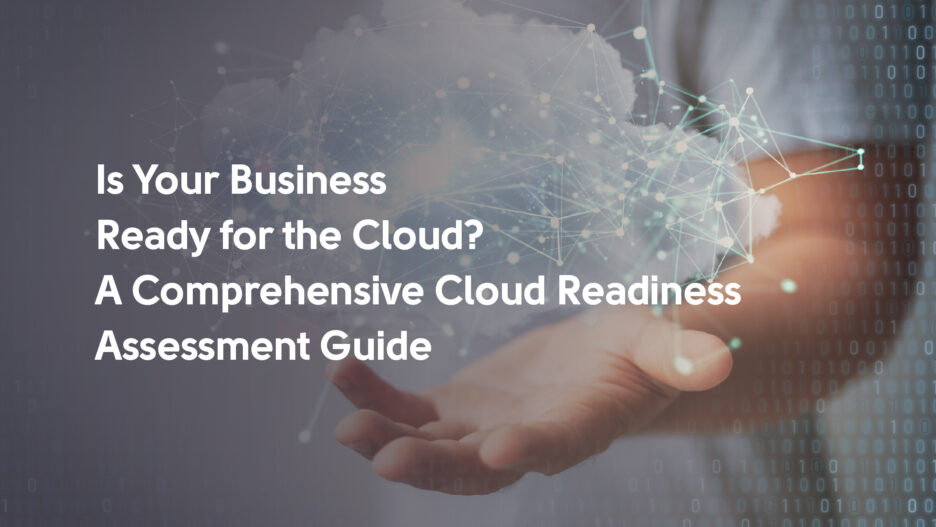As more businesses look to migrate their IT infrastructure to the cloud, cloud readiness assessment is crucial. Basically, it determines if an organization is prepared for cloud services and identifies areas of weakness. The comprehensive cloud readiness assessment helps you understand your business's current state and develop tailored strategies to ensure a successful transition.
But how do you ensure you're ready without extra complications and costs? In this article, we'll explore how to evaluate your cloud migration readiness assessment and offer you a handy checklist.
What is Cloud Readiness Assessment?
A cloud readiness assessment is essential for businesses planning to move to the cloud. It evaluates the current business processes, IT setup, applications, data, and employee skills to see if the organization is ready for the cloud and to find the best cloud migration strategy. This assessment, even for non-technical companies, focuses on adapting business processes to a cloud environment, ensuring a seamless transition and alignment with overall business objectives.
This assessment looks at cloud migration's feasibility, risks, and benefits. It also considers business goals, budget limits, compliance needs, and how it will affect stakeholders. The assessment produces a roadmap, guiding companies through cloud adoption. It highlights areas requiring improvement, such as upgrading the network, adapting applications for the cloud, and addressing security and data compliance issues.
Doing this ensures a smooth, cost-effective transition that aligns with business goals. Understanding the purpose of cloud readiness assessment helps organizations make smart decisions, positioning them for success in a cloud-based world. It's about making choices that support business success, not just moving data and application to the cloud.
Cloud Migration Challenges
Moving to the cloud offers many benefits. Yet it’s also associated with certain challenges. Let's discuss five of the most important ones and their solutions.
Challenge #1. Data Security and Privacy
Many organizations are hesitant to trust third-party vendors with their sensitive data, despite the generally secure nature of cloud environments. Data breaches during migration can lead to service disruptions and vulnerabilities, particularly with sensitive data.
Solution: Implement encryption at rest and in transit to protect data. Use identity and access management (IAM) systems to control access and set permissions based on the least-privilege principle. Leverage cloud-native or 3rd party tools to regularly monitor data access and detect potential security threats with cloud services. Choose a reputable cloud service provider that adheres to regulations and maintains stringent security protocols.
Challenge #2. Regulatory Compliance
Compliance with industry-specific regulations like GDPR, PCI DSS, and HIPAA can be challenging in a cloud environment. Frequent changes and manual processes add complexity, consuming valuable IT resources.
Solution: Work closely with your cloud provider to ensure all regulations are followed. Engage legal and compliance specialists to provide expert guidance. Utilize voluntary compliance standards and frameworks such as the NIST Cybersecurity Framework and CIS Benchmarks to maintain a secure and compliant environment.
Ensure GDPR compliance by storing data in appropriate regions and implementing controls to prevent unauthorized data movement. For HIPAA compliance, utilize cloud services that detect unencrypted personal data and notify you of PII and confidential data in external messages and logs. Leverage centralized management services from large cloud providers to collect and display all PII data findings in one place, improving management, simplifying automation for automatic remediation, and enhancing overall compliance efforts.
Challenge #3. Cost Management
Cloud migration can initially seem costly due to migration expenses and training needs. Unexpected costs can arise from inefficient resource use, wrong technical decisions and lack of planning.
Solution: Invite an external consulting company (like Svitla Systems) to design cost estimation for each cloud migration stage. Use your cloud provider's cost management tools to monitor and control expenses. Ensure efficient use of cloud resources to prevent unnecessary costs. Develop a detailed budget and plan for initial and long-term migration costs.
Challenge #4. Skill Gap
A lack of cloud expertise can hinder migration efforts. Existing teams may need to upgrade their skills, and organizations often face significant training costs.
Solution: Invest in comprehensive training programs for your current staff to ensure they have the necessary skills to manage the migration effectively. Recruit new talent with cloud expertise as needed. Consider partnering with a managed services provider to bridge skill gaps during the transition.
Challenge #5. Lack of a Proper Migration Plan
Businesses risk problems during cloud adoption without a detailed migration plan. Critical applications and processes need careful consideration and strategy to avoid issues.
Solution: Start with a detailed migration plan. Assess your business goals and current assets to select the right strategy and integration points. Plan migration stages carefully, including a phase to test assumptions with a few applications before full migration. Outline key migrated business systems to adjust or rebuild after the move for a seamless transition.
Key Components of Cloud Migration Readiness Assessment
Successful transition to the cloud requires a thorough assessment of several critical areas. Below are the key components of cloud readiness that organizations need to evaluate:
Technical Readiness
Technical readiness involves evaluating your current IT infrastructure, applications, and data to ensure they are compatible with the cloud. This includes assessing the complexity of existing systems, identifying any necessary upgrades, and determining the best approach for migrating applications and data. Consider network bandwidth, server capacity, software dependencies, and data storage needs.
Operational Readiness
Operational readiness examines your organization's processes and workflows to ensure they can support cloud operations. This includes assessing the skills and expertise of your IT staff, ensuring effective change management, and establishing procedures for ongoing cloud management and maintenance. Evaluate current operational procedures, training needs, and support structures to ensure a seamless transition to cloud operations.
Financial Readiness
Financial readiness focuses on understanding cloud migration costs and ongoing cloud operations. This includes evaluating initial migration costs, long-term operational expenses, sinking/retiring of the used hardware and software, and potential cost savings. Developing a detailed budget and ensuring efficient resource use is essential to prevent unexpected expenses. Consider costs related to software licensing, data transfer, training, and potential downtime during migration.
Security and Compliance Readiness
Security and compliance readiness ensures your cloud environment meets all security standards and regulatory requirements. This includes implementing robust security measures, such as encryption and identity management, and ensuring compliance with industry-specific regulations like GDPR, PCI DSS, and HIPAA. Assess current security policies, identify gaps, and develop a compliance roadmap to address regulatory requirements.
Now, that you know the key components of assessment, let’s move on to the application assessment checklist for cloud readiness.
How to Conduct Cloud Readiness Assessment?
A cloud readiness assessment checklist provides a full list of criteria and considerations for a smooth transition. This way, companies can prepare for changes more easily. Here are some basic cloud readiness assessment questions you should clarify before the transition:
Strategic Alignment
- Define clear business objectives for cloud adoption
- Ensure alignment between cloud goals and overall business strategy
- Formulate targets per the architecture and service selection on the respective cloud infrastructure platform
- Decide on the cloud approach (Public Cloud, Hybrid Cloud, Multi-Cloud, etc.)
- Identify business processes affected by cloud migration
- Analyze requirements (location choice, compliance, SLA)
Technology and Infrastructure
- Catalog existing IT assets, including hardware, software, and network resources
- Inventory current architecture and sizing (TCO, load scenarios, portability concepts)
- Assess current applications for cloud suitability
- Evaluate the need to re-architect applications for the cloud
Security and Compliance
- Identify all relevant data protection and privacy regulations
- Assess current security posture and compliance status
- Plan for cloud security controls and compliance mechanisms
- Review data sovereignty and data governance requirements
Financial Cloud Migration Analysis
- Analyze current IT expenditures.
- Forecast cloud-related costs, including migration and operational expenses
- Identify potential cost savings and return on investment (ROI)
Organizational Readiness
- Evaluate current IT staff skill levels and identify training needs
- Develop a change management plan to address cultural shifts
- Communicate cloud strategy to stakeholders to gain buy-in
Operational Impact
- Determine the impact on existing IT operations and support
- Plan for integration with on-premises systems and third-party services
- Establish performance metrics and quality of service expectations
Migration Planning
- Identify applications to be migrated
- Decide on lift & shift or rebuild strategies
- Analyze the architecture to be adapted (API and interface discovery)
- Develop a phased migration plan with clear milestones and deliverables
- Identify quick wins to demonstrate early success in cloud adoption
- Create a disaster recovery and data backup strategy for the cloud
Vendor and Service Selection
- Evaluate potential cloud service providers (CSPs)
- Compare service level agreements of various CSPs
- Select reliable consulting and implementation partner
Svitla System’s Experience in Cloud Migration
Our team has extensive experience in transition services. We have successfully assisted in application assessment for cloud migration to many companies. Let’s explore some of our cases.
Cloud Services for SCM
Our client, a publicly traded US technology company, engaged Svitla Systems to enhance their cloud-based spending and supply chain management platform. We conducted an AWS migration readiness assessment to ensure seamless operations, improved security, and scalability. We managed AWS infrastructure using the AWS cloud adoption framework, resolved containerized application issues with Kubernetes and Amazon ECR, and troubleshooted AWS Lambda functions. We also addressed CI/CD pipeline problems with Jenkins, ArgoCD, and GitHub, and improved infrastructure setup with Terraform and Chef.
As a result, the company experienced increased operational efficiency, faster time-to-market, and enhanced business agility. Our efforts also improved application security through container isolation and log audits. These enhancements led to higher end-user satisfaction and a stronger brand reputation.
Cloud Services for a Fashion Platform
Svitla Systems helped a multi-brand retailer enhance its e-commerce platform by conducting a comprehensive cloud migration risk assessment and application cloud readiness assessment. We deployed AWS Organizations for account management, implemented AWS Control Tower and Landing Zone for governance, and centralized security with AWS Security Hub. We also modernized their networking architecture, transitioned to native cloud services, and established robust disaster recovery scenarios.
As a result, the company experienced increased profits through an improved customer loyalty program and an upgraded e-commerce admin platform. The transition to multi-account AWS environments improved security and observability while migrating to cloud-native services enhanced system resilience, scalability, and GDPR compliance. This comprehensive approach ensured a scalable, secure, and efficient infrastructure, significantly boosting operational efficiency and customer satisfaction.
Conclusion
Cloud computing offers efficiency, innovation, and scalability. Starting with a thorough Cloud Readiness Assessment helps your organization fully benefit from cloud adoption. You ensure a smooth and strategic transition by following the steps and using the right application assessment tool for cloud migration.
A cloud readiness assessment aims to guide your way forward, highlighting both challenges and opportunities in the cloud. It prepares your business for a future where agility, resilience, and innovation are key to success.
Use this guide, apply the cloud assessment checklist, and confidently move forward. Your cloud journey is about achieving more and redefining what your business can do in a connected cloud-powered world.
Svitla Systems offers comprehensive cloud computing readiness assessment services. Contact us, so we can explore your current situation and offer a seamless transition.
FAQ
What is a cloud readiness assessment?
A cloud readiness assessment evaluates an organization's current IT infrastructure, applications, data, and employee skills to determine readiness for cloud migration and identify the best cloud strategy.
How do you perform a cloud readiness assessment?
To perform a cloud readiness assessment, analyze your IT infrastructure, applications, and data. Evaluate your team's cloud skills, set clear business goals, assess security and compliance requirements, and review budget constraints.
What are the requirements for cloud assessment?
The requirements for a cloud assessment include detailed knowledge of your IT infrastructure, applications, data, business goals, security, compliance needs, team cloud skills, and budget limits.
Why is cloud assessment important?
A cloud assessment is important because it ensures a smooth and cost-effective migration, aligns the migration with business objectives, identifies potential risks, and addresses security and compliance issues.





![[Blog cover] SEO optimization best practices](https://svitla.com/wp-content/uploads/2025/05/Blog-cover-SEO-optimization-best-practices-560x310.jpg)